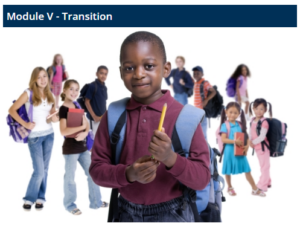
Transition, Self-Determination, and Social and Emotional Learning to Support Student Success
By LaShauna Britt, M.Ed. and Debbie Grosser, Ed.D.
———————————————————————-

Facilitating & Monitoring Inclusive Transition Planning
By Cathy Buyrn, M.Ed.
School leaders at all levels are responsible for facilitating and monitoring evidence-based transition supports for students with disabilities. Students with disabilities should be included in the same general education practices of supporting common transitions between grades and school levels, developing Academic and Career Planning Portfolios in elementary school, and designing Academic and Career Plans of Study in middle and high school. These activities do not replace transition services required by the Individuals with Disabilities Act (IDEA, 2004).
The current Link Lines Educators’ Lesson, Transition, Self-Determination, and Social and Emotional Learning to Support Student Success, provided teachers responsible for transition services with information focused on critical aspects of transition planning and links to tools that can facilitate best practices. Administrators should ensure that special education teachers attend to transition activities designed to meet the unique needs of students on their caseloads and that they communicate with students’ prior and future service providers. While there are mandated transition requirements at various points throughout a student’s school career, teachers should address transition supports whenever a student is moving from one stage of development to another and between schools or levels (i.e., primary, elementary, middle, high) or between different service delivery models (e.g., self-contained, resource, full inclusion).
Students with disabilities may benefit from services as early as age two. For those students, transition services should be addressed when they move from Early Intervention (IDEA Part B) to Early Childhood Special Education (ECSE) (IDEA Part C) and then again from ECSE to kindergarten. Information and support for school leaders supervising early childhood transitions can be obtained from The Virginia Department of Education and The Training and Technical Assistance Center at Old Dominion University (ODU). Most transition services supervised by K-12 school leaders are focused on secondary transition designed to “facilitate movement from school to post-school activities” (Virginia Department of Education [VDOE], 2015, para. 1).
In Virginia these transition services must be addressed in a student’s Individualized Educational Program (IEP) during the academic year in which they turn 14 (VDOE, 2015), but they should be addressed throughout the PreK-12 experience. Transition assessments and preliminary planning should begin before the eighth grade to set students up for success. The Link Lines Educators’ Lesson provides valuable information regarding foundational skills (i.e., self-determination, social emotional learning) that support transition planning. School leaders and teachers responsible for secondary transition planning can access additional resources and tools designed to build knowledge and support effective planning below.
Click Image to Play Module
School leaders should communicate that transition planning and services for students with disabilities are not stand-alone activities for a small number of students and that they do not begin only when legally required at age 14. Transition activities should be embedded within inclusive practices across school settings and action plans (VDOE, 2019). A school-wide focus on self-determination and social emotional learning based on the principles of Universal Design for Learning (UDL) can provide critical foundational support. At the same time UDL transition practices are implemented, special educators need to engage in ongoing transition assessments, develop future-focused goals, and provide services designed to help students achieve those goals. When school leaders facilitate and monitor transition activities designed to develop complementary academic and functional skills, students with disabilities will be more likely to experience independence and success in their post-secondary lives (VDOE, 2019).
References
Individuals with Disabilities Education Act, 20 U.S.C. §1400 (2004). https://sites.ed.gov/idea/
Virginia Department of Education. (2015). Secondary transition: Why it is important to plan early [Fast fact]. https://www.doe.virginia.gov/special_ed/regulations/state/fast_facts/fast_fact_secondary_transition.pdf
Virginia Department of Education. (2019). K-12 inclusive practices guide. https://www.doe.virginia.gov/special_ed/iep_instruct_svcs/inclusive/k-12-inclusive-practices-guide.pdf






